F3D2 & EF-10B Skyknight
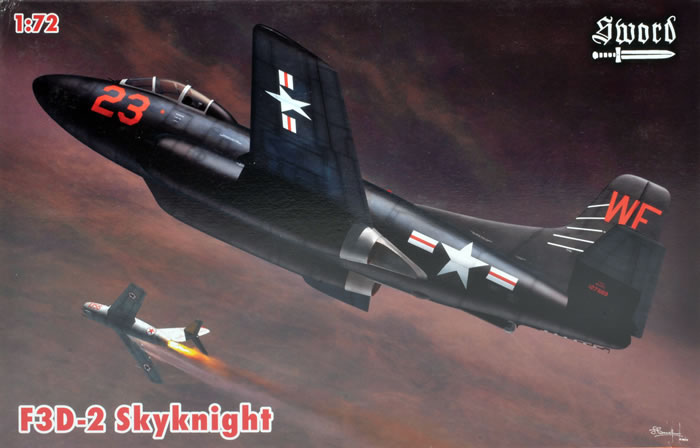
Sword, 1/72 scale
S u m m a r y : |
Catalogue Number: |
Sword Kit Nos.
SW72074 - F3D2 Skyknight
SW72075 - EF-10B Skyknight |
Scale: |
1/72 |
Contents & Media |
Each kit has sixty-nine grey and three clear styrene parts, and decals for five colour scheme options. |
Price: |
Available on-line from these stockists: |
Box # / Version |
Hannants |
Squadron |
Modelimex |
SW72074 / F3D-2 |
£14.06 |
US$38.99 |
€15.42 |
SW72075 / EF-10B |
£14.06 |
US$38.99 |
€15.42 |
Click here for currency conversion. |
Review Type: |
First Look. |
Advantages: |
These are good quality kits with nice surface and interior detail. A significant improvement on previous Skyknight kits in this scale. |
Disadvantages: |
Paint colour information is generic, and the shaded diagrams do not mention the main airframe colours. |
Conclusions: |
These nicely are engineered kits produced to high standards, but are let down just a little by inadequate camouflage colour information. They look to be nice and straightforward to build, with the potential to produce very attractive and interesting models. Detail levels are good all-round; they appear to be a real advance over the old Matchbox kit in all respects. - Definitely recommended. |
Reviewed by
Mark Davies

Sword's 1/72 scale Skyknights are available online from
Squadron.com
First flown in March 1948, the F3D Skyknight was a jet night & all-weather fighter capable of operating from aircraft carriers; it would remain in service until mid-1970. Like many early straight wing jets, its performance was soon to be outclassed and superseded by more advanced designs. However, it was still responsible for downing more enemy aircraft in the Korean War than any other US Navy type.

The design specification called for a very large radar dish able to track targets out to 125 miles, a huge range for the time; but this in turn needed a wide fuselage cross-section to fit the enormous Westinghouse APQ-35, which used about 300 vacuum valves. The bulky but roomy airframe extended the design's usefulness after more capable all-weather fighters replaced it, as its spaciousness allowed plenty of avionics to be carried. It was used on early radar-guided missile tests and served in an electronic warfare role during the Vietnam War.

An interesting feature of the design was its weight-saving use of an escape tunnel rather than ejection seats for the crew (a similar feature used by Douglas on the A-3 carrier-borne jet-bomber too). A far more detailed background to the Skyknight and its history can be found at wikipedia.
Previous 1/72 Scale Skyknight Kits
I am aware of four previous F3D kits in The One True Scale, three being Vac-forms from Air Model, Rereplanes, and Falcon (which included some white metal parts). All are hard to find these days, and superseded by Matchbox's injected kit (possibly re-released by Revell Germany using Matchbox branding).
I built the Matchbox kit many years ago, and recall that it had easily removed raised surface detail and none of the horrible panel-line trenches often associated with their kits. The shape seemed good, as were the decals, but interior and undercarriage detail was typical of the brand, being simplified and soft. We are certainly due a more modern kit of this interesting design, especially as it seems to have a more popular following then its rather bland appearance would at first suggest. I am sure that many will welcome Sword's new kit.
Contents
The kits, which share the same sprues, come in typically Czech end-opening boxes with digital artwork on their front. The plastic parts and decals come in a zip-lock bag, with the clear parts further enclosed in a small bag of their own.
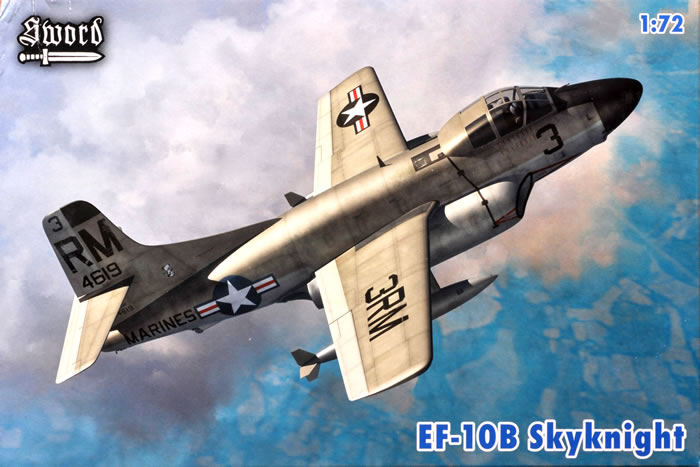
The instructions provide a parts map and easy to follow diagrammatic assembly format. The diagrams are well drawn, and in fact far better than some mainstream brands. There is also a brief history of the aircraft. Generic paint colours are given in Czech and English, with all other text in English. The painting and decal guides use just adequate black & white shaded drawings in the instructions (four-view for the EF-10B, but only two-view for the F3D-2). They mention detail and underside colours but fail to list the upper surface or main airframe colours, leaving this to be deduced by looking at the colour profiles on the rear of the box. I feel that Sword could have done a lot better here, and describe the correct colours using USN names, FS-595 equivalents, and/or model paint range cross-references.
The Kit
This is a typical Sword kit in that the cleanly moulded parts have very fine surface detail, and the sprue gates are narrow. There is just a little flash in places, but this is easy to deal with. There are no resin parts, unlike many earlier Sword kits. Parts break down is largely conventional for the type.
Cockpit detail is a huge advance on the old Matchbox kit, and is quite comprehensive for an all-styrene effort. The seats have no harnesses moulded with them, but it is worth adding homemade or PE belts to dress things up some more.
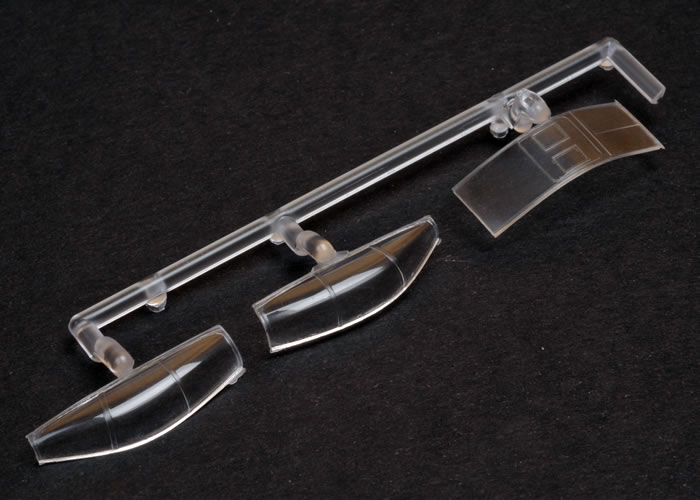
The airframe is a very straightforward affair, and I envisage these kits being quite quick to assemble. The integral engine nacelles are moulded separately from the main fuselage halves, and have internal intake and exhaust ducts included, along with their respective compressor and turbine faces. The engine nacelles fit into deep rebates in the fuselage halves, which I think should make for filler-free joins along their length. However, I suspect that some filler and sanding will be needed to blend the inlets and their ducting. This job is the only "pain", and a slight one at that, that I can foresee.
The undercarriage is nicely done and quite adequate for the scale, and is much better than the Matchbox kit's, with crisper moulding and more detail on the inside faces of the undercarriage doors. Two drop-tanks and their pylons are the only external stores provided, and will suffice for most options. The instructions show the pylons drawn with sway-braces, whereas the actual kit pylons only have small stubs where the sway-braces should be. The canopy is a three-piece affair to enable the bulged sides to be moulded, so care will be needed when joining these to the curved centre-section. The canopy is clear and quite thin, with crisply moulded framing that is much better than the heavier style of the Matchbox kit.
Overall, I should think that this kit should be a simple and enjoyable one to build.
Marking Options
The decals are printed by Eduard, and well registered and appear to have good opacity. I am sure they will prove to be excellent to apply based on my experience of this brand. They include quite a few stencil markings, whose locations are detailed in a separate page of the instructions. The subjects covered are:
Box # SW72074:
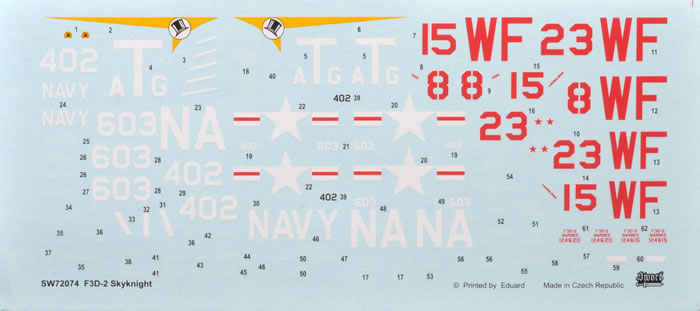
-
F3D-2, 124620, VMF(N)-513, USMC, Pyon Taek AB, Korea, 1953.
-
F3D-2, VMF(N)-513, USMC, Pyon Taek AB, Korea, 1953.
-
F3D-2, 124615, VMF(N)-513, USMC, K-6 AB, Korea, 1955.
-
F3D-2, 127022, VC-4, "Nightcappers"CVA-42 USS Franklin D. Roosevelt, 1952.
-
F3D-2, 127072, VF-14, Air Task Group 201, CVA-11 USS Intrepid, Autumn 1954.
Box # SW72075:
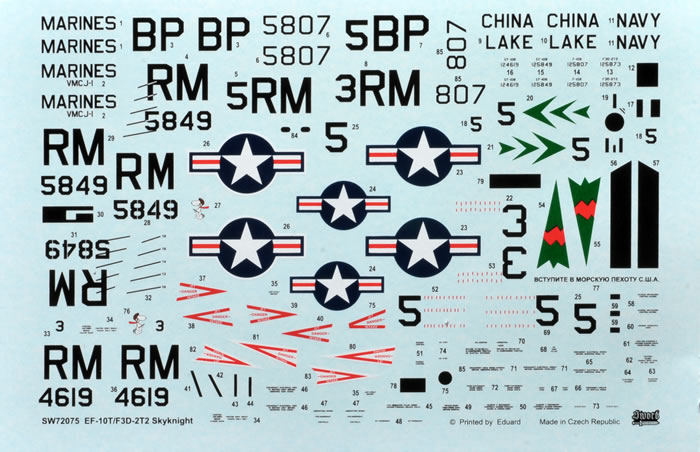
-
EF-10B, 124619, VMCJ-1, 1969.
-
EF-10B, 125849, VMCJ-1, Da Nang, Vietnam, 1965.
-
EF-10B, 125849, VMCJ-1, 1969.
-
F3D-2T2, 125873, VMFT(N)-20, FAWTULANT Boca Chica Air Base, Key West, Florida, 1959.
-
EF-10B, 125807, China Lake Weapons Test Centre, 1961.
These are good quality kits with nice surface and interior detail. Paint colour information is generic, and the shaded diagrams do not mention the main airframe colours. Most modellers will know which colours to use, but Sword is behind its competitors in this respect.
These are nicely engineered kits produced to high standards. They look to be very straightforward to build, with the potential to produce attractive and interesting models. Detail levels are good all-round; they appear to be a real advance over the old Matchbox kit in all respects.
Definitely Recommended.
Thanks to Sword Models for this review sample.
Review Text & Blue Background Images Copyright © 2013 by Mark Davies
Page Created 9 December, 2013
Last updated
11 December, 2013
Back to HyperScale Main Page

|
